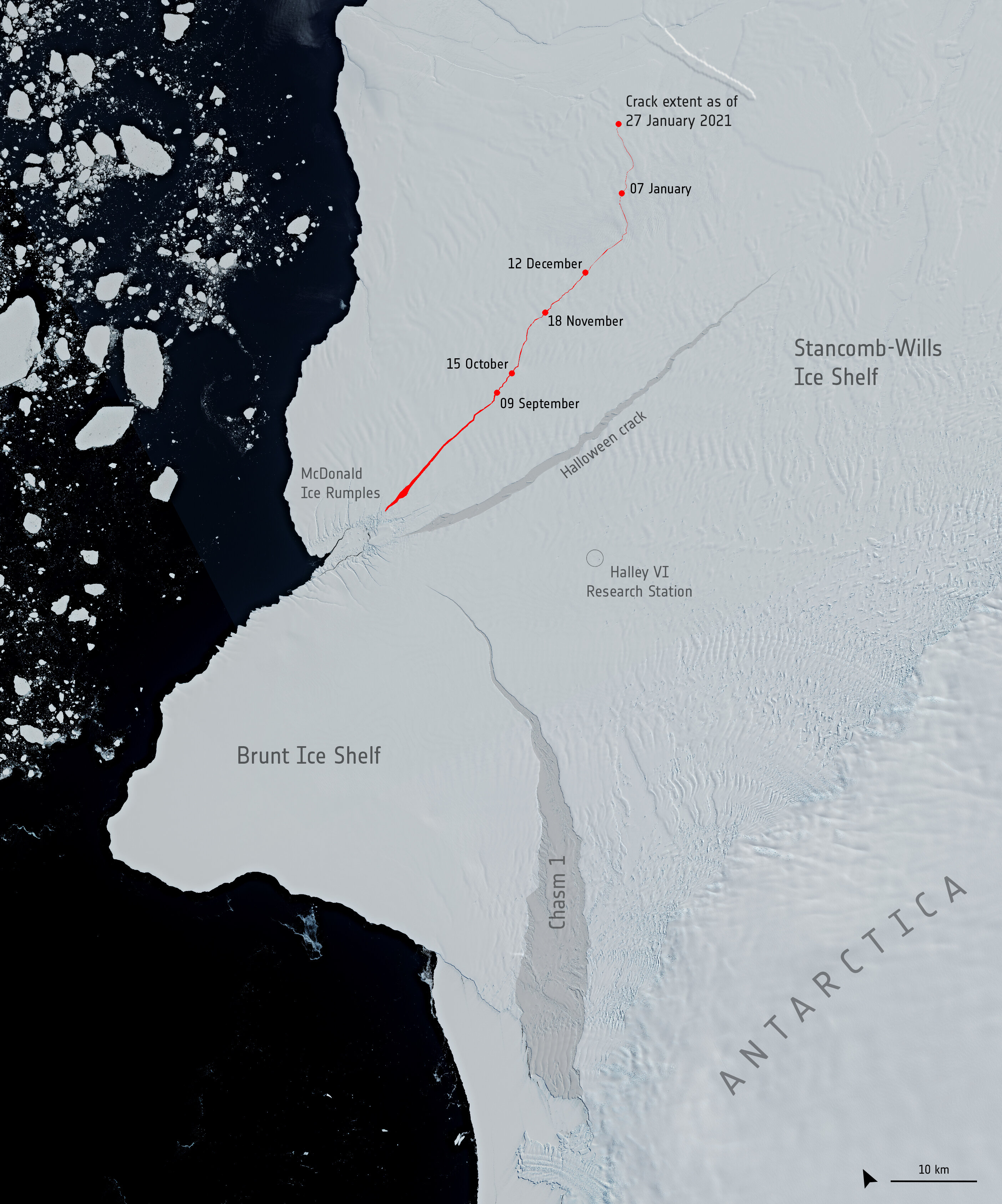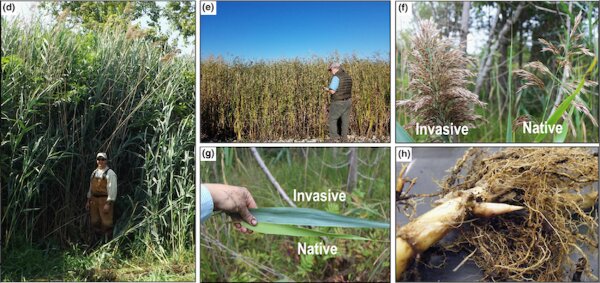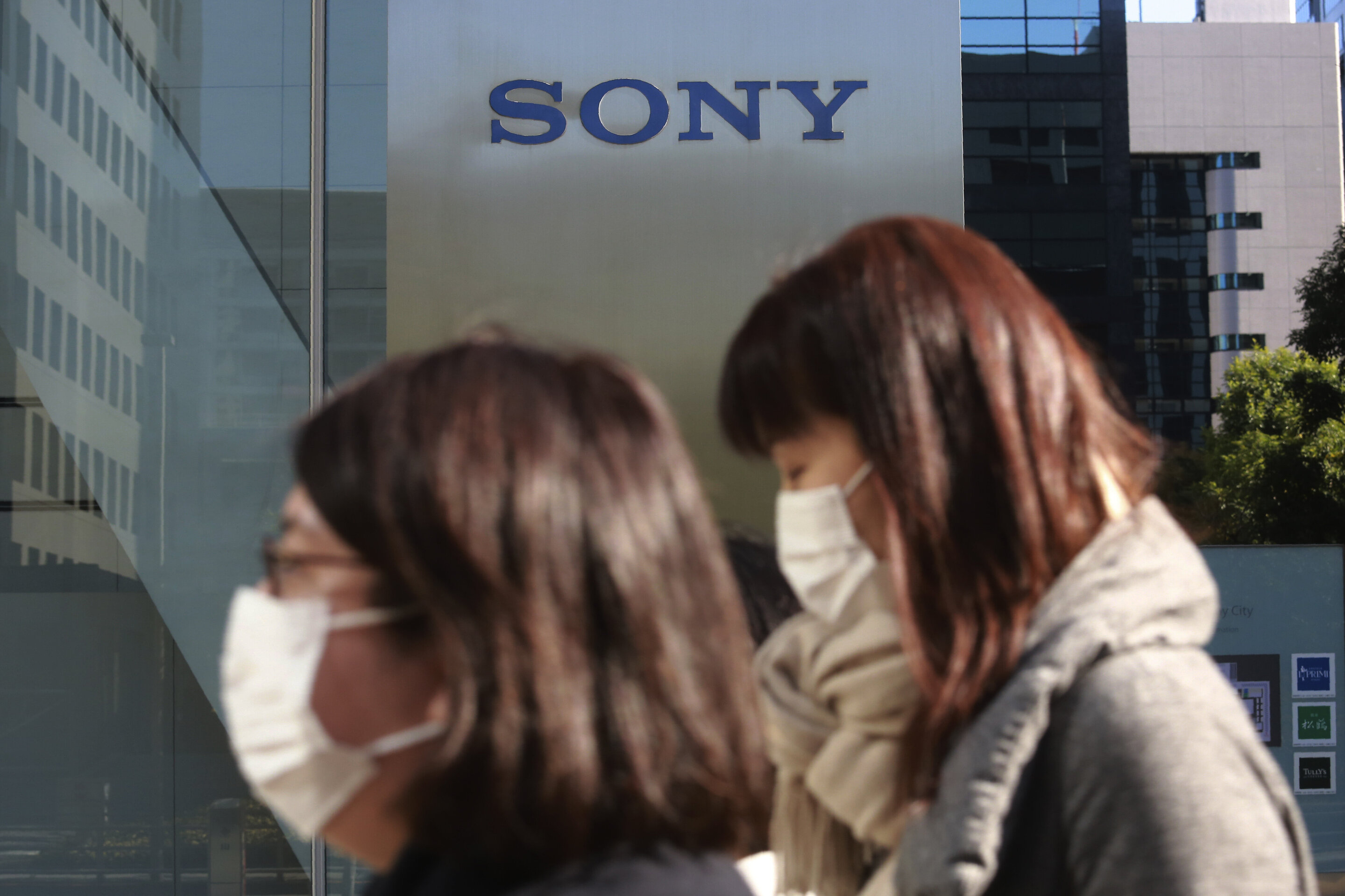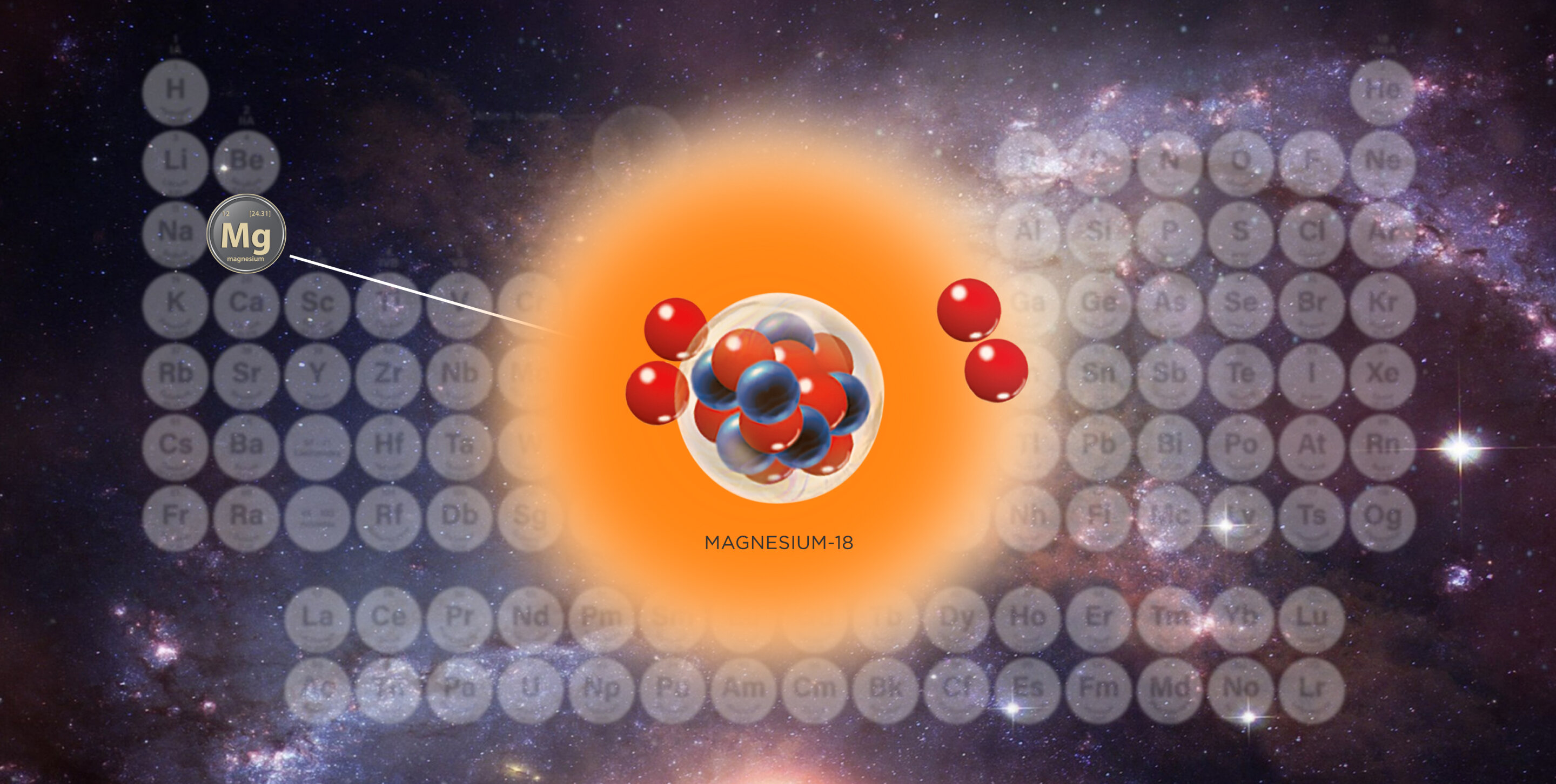#Compact nanoscale textures reduce contact time of bouncing droplets
“#Compact nanoscale textures reduce contact time of bouncing droplets”
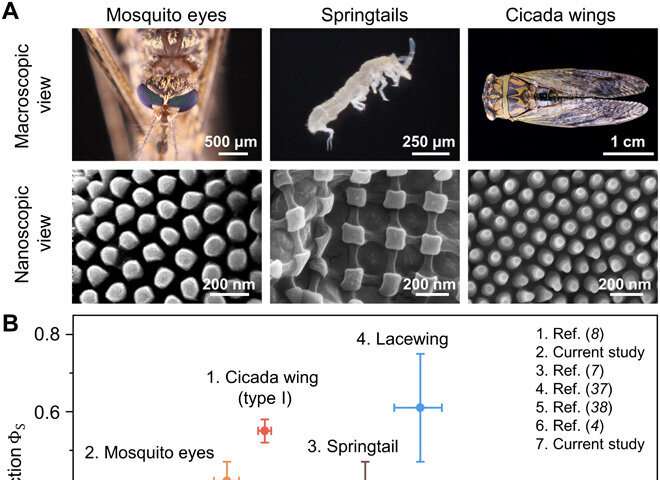
Many natural surfaces can rapidly shed water droplets due to their water-repellent functionality. In 1945, scientists Cassie and Baxter linked the water-repellent function of natural surfaces to their surface textures. The use of low solid fraction textures (denoted Φs) is therefore a key principle to design water-repellent surfaces. In this work, Lin Wang and a team of scientists in materials science, biomedical engineering and mechanical engineering at the Pennsylvania State University, U.S. reduced the contact time of bouncing droplets on high solid fraction surfaces (i.e. Φs ~ 0.25 to 0.65) by reducing the surface texture size to the nanoscale. They showed how high solid fraction surfaces with a texture size below 100 nanometers could reduce the contact time of bouncing droplets by approximately 2.6 milliseconds (ms) compared to a texture size above 300 nm. The texture and size-dependent contact time reduction observed on solid surfaces is a first-in-study outcome relative to existing theories on surface wettability. Wang et al. credited the reduction in droplet contact on nanoscale surfaces to the dominant three-phase contact line tension. Based on pressure stability experiments, the team further showed how surface solid fractions were bioinspired by insects that can withstand the impact of raindrops. The results are now published on Science Advances.
Nanoscale surfaces have diverse roles in biological organisms with importance for insect survival, examples include anti-reflection properties of moth eyes, antifogging properties of mosquitoes, self-cleaning techniques of cicada and anti-biofouling of dragonfly. The rapid detachment of raindrops on flying insects is also critical for their survival. For instance, the impact duration of raindrops on mosquitoes approximated 0.5 to 10 ms; a time frame of combined active and passive droplet shedding mechanisms. Plants and butterfly wings can also maintain microscale patterns to break the impact of droplets into smaller pieces to reduce droplet contact time. However, materials scientists must still understand how the high solid fraction and nanoscale textures of water-repellent insect surfaces can cause rapid detachment of raindrops on impact. To explore texture size effects and liquid-solid interactions, Wang et al. engineered a series of bioinspired, insect-like textured surfaces, coated them with a silane monolayer to induce surface hydrophobicity (water-hating nature) and conducted a series of experiments.
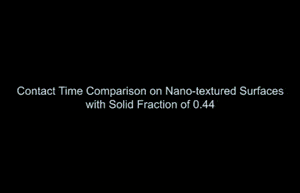
Measuring the contact time of bouncing droplets on textured surfaces
During the experiments, the team maintained the Cassie-Baxter state (heterogenous surface wetting) with the test liquid droplets and compared the contact time of bouncing water droplets on textured surfaces. Surfaces with a texture size smaller than 300 nm showed decreased contact time for bouncing droplets. The texture size-dependent reduction of droplet contact on solid surfaces was a first-in-study compared to existing surface wetting theories.
In theory, the contact time can be predicted relative to the density and surface tension of water. When a liquid droplet impacted a textured surface, it spread to a maximum diameter and retracted from the surface much like a ‘liquid spring.” On low solid fraction textured surfaces, the liquid-air interfacial tension of the droplet dominated the spring constant of the liquid spring. Meanwhile any contributions from liquid-solid interactions could be ignored. However, scientists could not ignore liquid-solid interactions on high solid fraction textured surfaces where Φs equalled 0.44, due to additional energy resulting from the formation of three-phase contact lines beneath the droplets to influence their bouncing energies. For this, Wang et al. considered the three-phase contact line tension (τ), first introduced by Gibbs in the 1870s, where the experimental measurements of τ depended on the specific system under investigation.
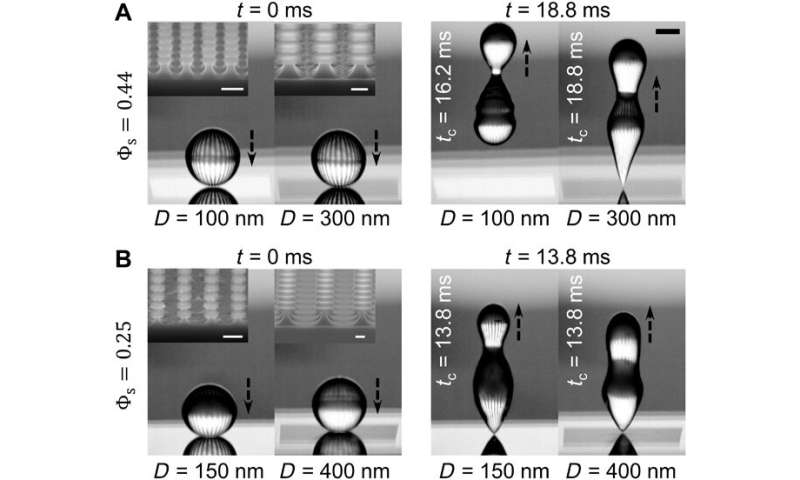
Kinematics of bouncing droplets on textured surfaces and the pressure stability of surfaces
To further understand the reduction in contact time of droplets impacting nanoscale surfaces, Wang et al. investigated the kinematics of bouncing droplets based on spreading and retracting processes. While velocities of droplet spreading were similar on different surfaces, during the phase of retraction, droplets took longer to fully retract from surfaces with higher solid fractions. The work showed how increased solid fraction therefore increased retraction time. For example, a droplet on a superhydrophobic black silicon surface could retract at a consistent velocity for droplets to recede at the fastest possible pace. Unexpectedly, therefore, Wang et al. noted superhydrophobic bouncing behavior on 100 nm surface textures with a solid fraction of 0.44
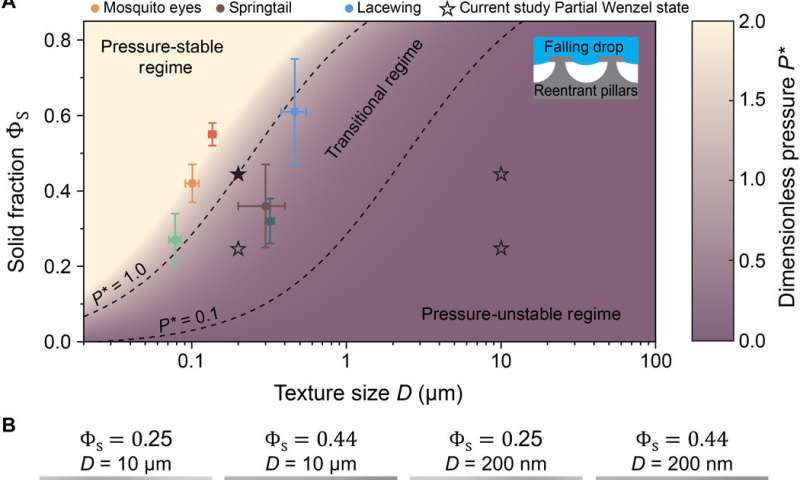
To understand the outcome, the scientists then developed a method to quantify the contact angle hysteresis by systematically measuring the advancing and receding contact angle on engineered surfaces. Surfaces with a higher solid fraction had delayed droplet retraction, notably deviating from the intended superhydrophobic bouncing behavior. It was therefore interesting to understand why water-repellent insect surfaces did not adopt textures with a lower solid fraction to get rid of water more effectively. For this, Wang et al. investigated the pressure stability of textured surfaces against impacting droplets when water droplets impacting a solid surface underwent two modes of impact pressures. The first mode was water hammer pressure at the liquid-solid contact surface and the second mode was dynamic pressure at the spreading stage. The team therefore showed high solid fraction to be an important requirement for insects to withstand the impact pressure of raindrops in order to completely shed them.
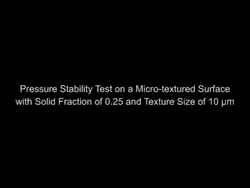
In this way, Lin Wang and colleagues showed how nanoscale textures on high solid surfaces reduced the contact time of bouncing droplets for the first time. The findings uncovered an unprecedented strategy to reduce the contact time of bouncing droplets on solid surfaces. The team achieved superhydrophobic bouncing behavior on high solid fraction surfaces (Φs = 0.44) with a nanoscale texture size approximating 100 nm. The findings shed light on how insects escape the high-speed impact of raindrops. The study provides experimental evidence to the necessity of high solid function textures in order to counter the impact pressure of raindrops. Technically, a compact nanoscale textured material that can repel high-speed impact of liquid droplets with reduced contact time will have a range of applications in facilitating fouling-resistant personal protective gear, for insect-sized flying robots and in miniaturized drones.
More information:
Lin Wang et al. Compact nanoscale textures reduce contact time of bouncing droplets, Science Advances (2020). DOI: 10.1126/sciadv.abb2307
A. B. D. CASSIE et al. Large Contact Angles of Plant and Animal Surfaces, Nature (2008). DOI: 10.1038/155021a0
Yahua Liu et al. Pancake bouncing on superhydrophobic surfaces, Nature Physics (2014). DOI: 10.1038/nphys2980
© 2020 Science X Network
Compact nanoscale textures reduce contact time of bouncing droplets (2020, July 28)
retrieved 28 July 2020
from https://phys.org/news/2020-07-compact-nanoscale-textures-contact-droplets.html
This document is subject to copyright. Apart from any fair dealing for the purpose of private study or research, no
part may be reproduced without the written permission. The content is provided for information purposes only.
If you want to read more Like this articles, you can visit our Science category.
if you want to watch Movies or Tv Shows go to Dizi.BuradaBiliyorum.Com for forums sites go to Forum.BuradaBiliyorum.Com
